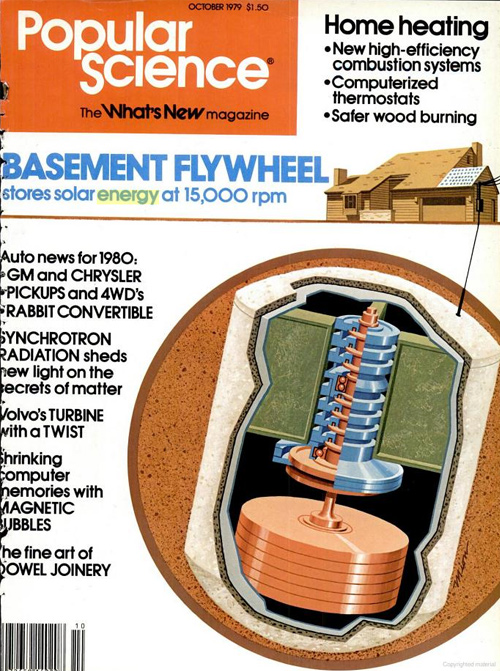Residential Energy Storage with Underground Flywheels
February 16th, 2011Update 2013: Velkess: New Residential Scale Flywheel Design
—
A reader asked if I knew of a better way of storing energy for an off grid house than the ancient and familiar lead acid battery bank. Knowing that there really isn’t, I thought I’d try to be funny, so I said, “How about a big flywheel?”
To my surprise, the guy wrote back and asked, “Do you know anyone who builds residential scale flywheel systems?”
I looked and, as far as I can tell, there isn’t anyone who offers a flywheel system for residential use, at any price. There are several companies that sell flywheel based UPS systems for data centers. I may be wrong, but it appears that those systems are designed to run for only about ten seconds while a backup diesel generator starts up.
I spent a few minutes looking into whether or not anyone had tried to use flywheels in a residential context.
Look at this: Popular Science, October 1979, Basement Flywheel Stores Solar Energy at 15,000 RPM:
Millner is building a one-tenth capacity working model of the giant system shown on our cover. The 500 pound flywheel will store up to four kilowatt hours. (A house-sized system would store about 40 kWh to meet the 25-kWh daily demand of an average home. Mechanical losses siphon off an extra five kWh. The rest remain in the wheel.) The flywheel will be suspended by six magnetic bearings (see diagram) when energy is being stored. Current from the solar array will drive an advanced permanent-magnet motor generator mounted on the flywheel shaft to accelerate the flywheel. When energy is to be withdrawn, the motor generator, plus a sophisticated semiconductor circuit, will convert mechanical energy storred in the spinning mass into a steady supply of AC for use in the house.
…
The entire assembly—bearings, motor generator, and flywheel—will be enclosed in a sealed vacuum container that doubles as a safety enclosure. This will be lowered into a concrete pit below the garage of a solar-powered test house MIT is building.
Isn’t it weird how an article that’s over three decades old reads pretty much like one written today when it comes to the topic of people being able to store energy that they collect on their own properties?
Anyway, so what happened? How did this project turn out?
This is from, Performance Testing and Economic Analysis of a Photovoltaic Flywheel Energy Storage and Conversion System:
A subscale prototype of a flywheel energy storage and conversion system for use with photovoltaic power systems of residential and intermediate load-center size has been designed, built and tested by MIT Lincoln Laboratory. System design, including details of such key components as magnetic bearings, motor generator, and power conditioning electronics, is described. Performance results of prototype testing are given and indicate that this system is the equal of or superior to battery-inverter systems for the same application. Results of cost and user-worth analysis show that residential systems are economically feasible in stand-alone and in some utility-interactive applications.
I felt pretty frustrated after reading all of this. Why can’t I buy one of these for my house?!
So, I searched again and found Regenerative Power and Motion. Their goal is to actually build these underground flywheel systems for homes and businesses. As of right now, though, it’s still not an option.
In 2011, are we any closer to being able to buy what MIT built and demonstrated to work all the way back in 1979? I guess not.

